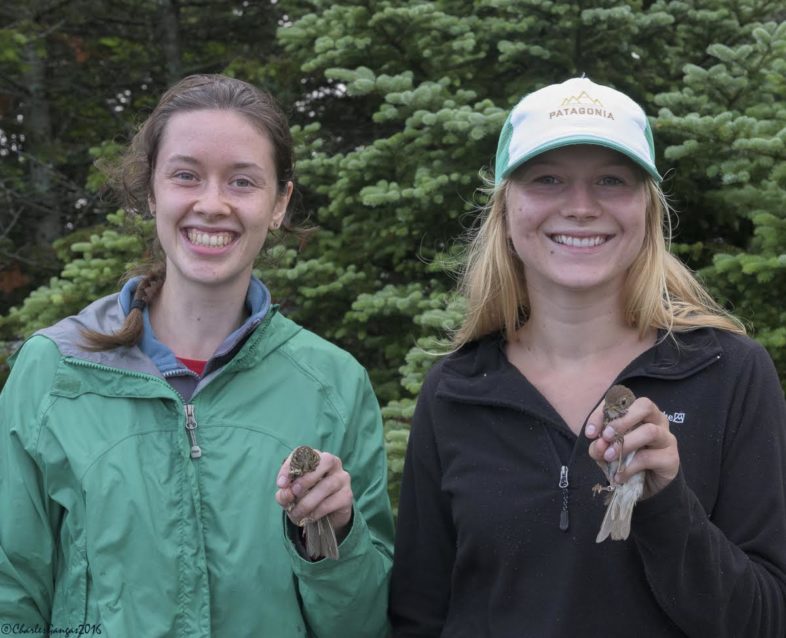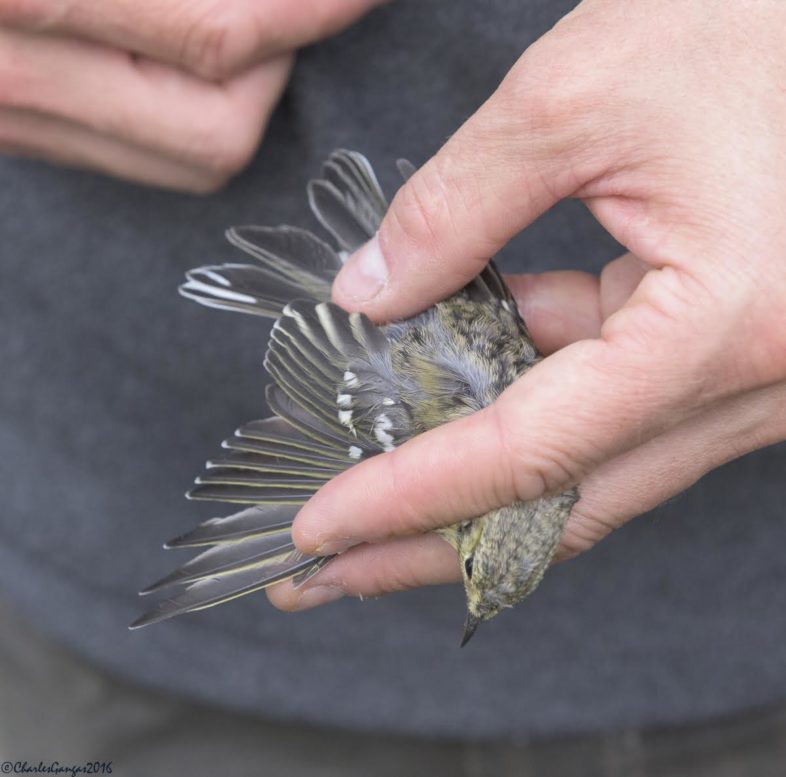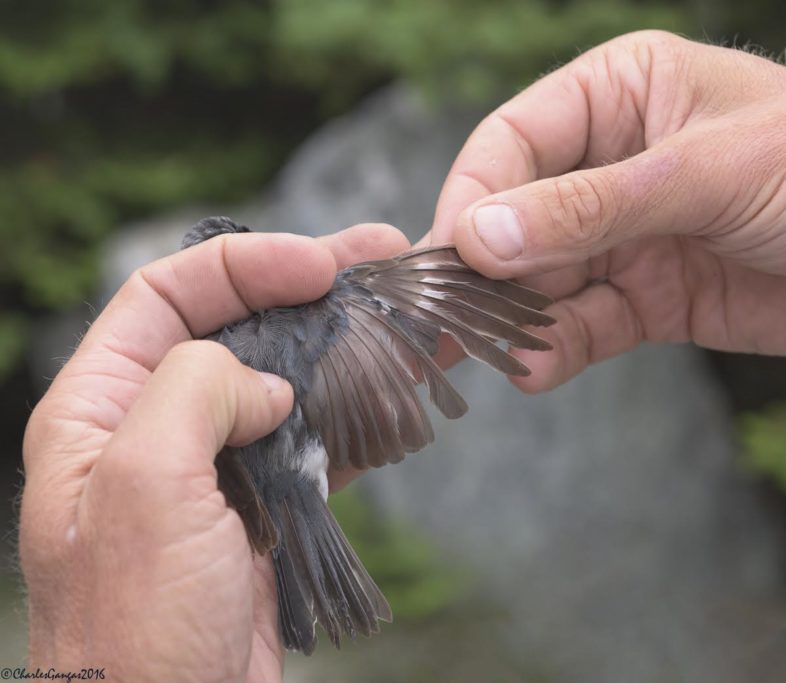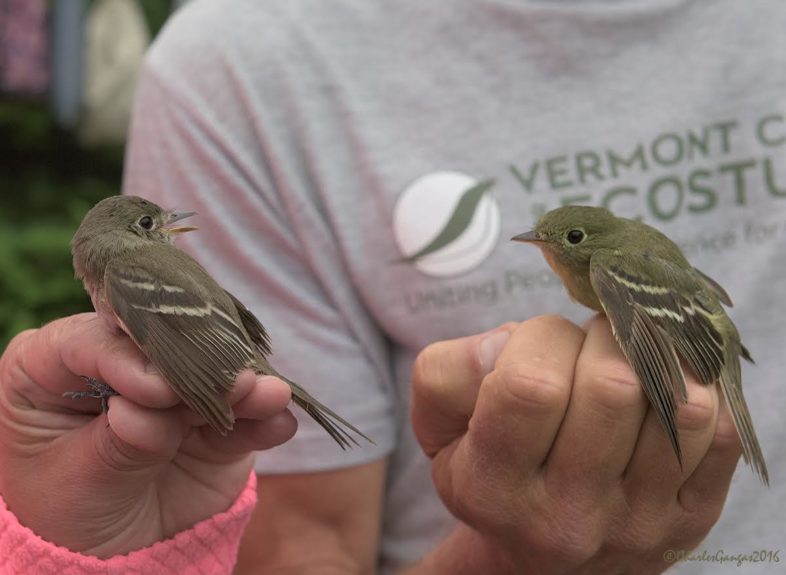
VCE Alexander Dickey Conservation Intern Amber Wolf (left) with a juvenile Bicknell’s Thrush and seasonal Field Biologist Grace Mitchum (right) with an adult, Mt. Mansfield, 14 July 2016. Photo courtesy of Chuck Gangas.
Signs of seasonal turnover were evident on Mt. Mansfield this week, as VCE hit the two-month mark in our 25th consecutive year of studying the ridgeline’s breeding birds. Free-flying juveniles, molting adults and non-local dispersers are beginning to supplant the resident breeders in our mist nets. Hoping to dodge predicted thunderstorms, Jason Hill, Susan Hindinger, Grace Mitchum, Amber Wolf and I arrived in early evening on July 13. Temperatures were as warm as they ever get at 3900′ elevation, with the mercury reading 73 degrees F and the air decidedly muggy, but just short of stifling, thanks to a steady 10-15 mph west wind.
We set our usual array of 25 mist nets, took in a fine sunset, and were grateful the t’storms passed north. By nightfall we had captured 10 birds, including the season’s first juvenile Bicknell’s Thrush (BITH) and Dark-eyed Junco. The dusk chorus was surprisingly robust, as BITH called and sang with gusto, complemented by the more subdued songs of Swainson’s Thrush and the sweet refrains of White-throated Sparrows.

A banded juvenile Blackpoll Warbler just prior to release. Photo courtesy of Chuck Gangas.
Clouds lowered onto the ridgeline overnight, but temperatures remained relatively balmy (61F at 4 am). Dawn emerged slowly as we began opening nets at 0415, but the sluggish avian activity picked up markedly as a rising sun worked to dispel the sweeping clouds. Banding was steady, and we accumulated 60 captures by the time nets were down in early afternoon. Blackpoll Warblers topped the numeric chart, with 17 individuals netted, including 5 new males, 5 new females, 2 juveniles, and 3 males from previous years. Surprisingly, none of us heard a single song all day, evidence that local adults are busy tending their young. Of the 11 adult Blackpolls we examined carefully for signs of flight feather molt, 8 had dropped their innermost primaries, signaling the imminent end of breeding activities and a switch to preparation for the long-distance southward migration. We captured several adults of other species in active primary molt, including a Black-throated Blue Warbler.

A yearling male Black-throated Blue Warbler in early primary molt. Photo courtesy of Chuck Gangas.
As always at this time of year, our nets yielded a few surprises. Foremost among them was an adult female Least Flycatcher, the first of this species we have captured on the ridgeline in 25 years, including the autumns of 1995-97, when we conducted a fall migration banding study. Obligingly, this bird was netted with a Yellow-bellied Flycatcher, providing a rare opportunity to simultaneously examine these two similar species. Other captures of non-local birds included a single adult female Downy Woodpecker and Blackburnian Warbler, and two adult Black-throated Blue Warblers. While it may not feel like summer is on the wane —and certainly no one wants to hear it — the birds are telling us that changes are in store.

An out-of-habitat adult Least (left) and perfectly-at-home Yellow-bellied Flycatcher (right) at 3900′ elevation on Mt. Mansfield, 14 July 2016. Photo courtesy of Chuck Gangas.

Thanks for the photo of the Least and YBFL together.. without seeing the yellow belly, they sure look alike! Great seasonal summary. Thanks.